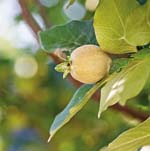How to grow quinces
Quinces are fragrant on the tree and can make delicious jelly says Alan Titchmarsh


If you want to buy any of the plants mentioned below for your own
garden, visit www.countrylife.co.uk/nursery and type or copy and paste
the name into the search. Plants are delivered in sturdy boxes in a
matter of days from one of the finest nurseries in the country.
There are some plants that need a firm hand with the secateurs-four quince trees in my garden that are grown as gigantic lollipops around a sparkling globe of water fall into that category. Until recently, aside from the Owl and the Pussycat, few people bothered with quinces, unless they were of the Japanese kind, more accurately known as Chaenomeles and valued for their winter flowers. But proper culinary quinces, the Cydonia oblonga of south-west Asia, have been more in evidence in recent years, probably thanks to Nigel Slater and others of his ilk, who have encouraged us to value them for their epicurean qualities.
My four are of the variety Meech's Prolific, discovered in Connecticut in the mid 19th century by the Rev William Meech. His quince is described as being a little tender in northern gardens in the UK, where it's recommended for growing by a warm wall. Here in Hampshire, my four specimens have thrived in the open for the past six or seven years, cropping heavily each autumn regardless of what the weather has thrown at them-and we've had plenty of snow and a fair few frosts. Above the 6ft-tall trunks, I've sculpted spherical heads of branches about 5ft in diameter.
So vigorous is their growth that I have to snip back any extension growths three or four times a year. The young foliage is attractively downy, and the stems are easy to snip off with an implement I've come to value highly-a pair of secateurs at the end of a 4ft extension shaft. The Dutch firm De Wiltfang (www.dewiltfang.com) manufactures them, and they do obviate the need to get out a stepladder every time a branch needs pruning above head height. Pruning the quinces has now become a pleasure rather than a chore.
Sign up for the Country Life Newsletter
Exquisite houses, the beauty of Nature, and how to get the most from your life, straight to your inbox.
The fruits themselves grow as big as your fist. They start off as downy ‘rosehips' before expanding into weighty ‘pears', during which process they turn pale green and then bright yellow. They're wonderfully aromatic and, of course, if you have the inclination, can be turned into delicious quince jelly. The white flowers preceding them are like gigantic apple blossom 21⁄2in across and for this alone, the trees would be worth growing, even if the floral joy is somewhat fleeting. Cooks will use their quinces in the kitchen, but any that are surplus to requirements will give off their fruity perfume if they're mounded up in a bowl on the table.
Taking stock
As the leaves fall, it's time to bite the bullet and take stock as far as other plants in my garden are concerned. What has done well, and what, if I'm honest, hasn't pulled its weight? Dug up and disposed of now, weedy border perennials and spindly shrubs offer planting opportunities at the perfect time of year-others can be planted to replace them and will have sunk their roots down by the time next year's growing season arrives.
But there are heartbreaking decisions, too. A pair of fastigiate hornbeams-such lovely trees, whose heads of branches are the shape of wide flames-flank a flight of steps in my garden. They're now eight years old and in that wonderful vigour of youth. Or they were. One of them has developed a bleeding form of canker at the base of the head of branches and, in spite of cutting out one or two infected branches in the hope of stopping the dieback, it continues to advance and death is but a year or two away.
As a single tree in this situation will look odd and unbalanced, both will have to go. Cutting down a healthy tree is never a pleasure, but I must remember the lessons of the hurricane of 1987 and the planting opportunities that followed. In a year or two, I will have forgotten the hornbeams and be enjoying whatever replaces them, rather than wistfully harking back to what once was.
* Subcribe
to Country Life magazine and get our new Ipad version free
Country Life is unlike any other magazine: the only glossy weekly on the newsstand and the only magazine that has been guest-edited by HRH The King not once, but twice. It is a celebration of modern rural life and all its diverse joys and pleasures — that was first published in Queen Victoria's Diamond Jubilee year. Our eclectic mixture of witty and informative content — from the most up-to-date property news and commentary and a coveted glimpse inside some of the UK's best houses and gardens, to gardening, the arts and interior design, written by experts in their field — still cannot be found in print or online, anywhere else.

